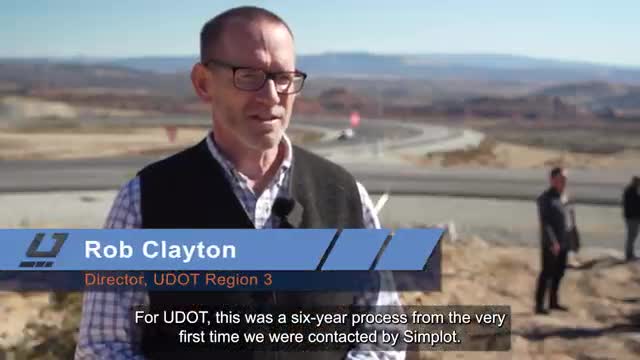Simplot moved 10 million cubic yards to enable new UDOT corridor, speakers say
October 23, 2025 | Utah Department of Transportation, Utah Government Divisions, Utah Legislative Branch, Utah
This article was created by AI summarizing key points discussed. AI makes mistakes, so for full details and context, please refer to the video of the full meeting. Please report any errors so we can fix them. Report an error »

Speakers at a public meeting described a public‑private partnership that moved roughly 10,000,000 cubic yards of earth to form a new highway corridor, a contribution they said made construction feasible at a lower cost and will allow a safer route through the Flaming Gorge area.
A Simplot representative said the company “moved over 10,000,000 cubic yards, material to form this new highway corridor,” and added that by relocating that quantity of material, “now it’s feasible for for UDOT to come in and say, okay. Now we can construct this highway at a reasonable price and really have a much safer, better highway to to go through here.”
The case for the partnership, one speaker said, began years earlier when Commissioner Van Tassel raised the project’s need and the timing. “We don’t have money to do it, but this is so bridal. And we would have done it maybe 20 or 30 years from now at a higher cost, but we saved the taxpayers dollars by doing it with a private company that wanted to help make this happen,” Speaker 1, Commenter, said. That speaker added, “It was a win win for them, win win for us, and more importantly for the citizens of Utah.”
A Utah Department of Transportation (UDOT) staff member described the change to the corridor as dramatic, calling it “a night and day difference from from the switchbacks that existed,” and said the improvement will affect both safety and convenience for motorists and for people traveling to recreate at Flaming Gorge.
Speakers also described planned reclamation steps after construction and mining end. A Simplot representative said workers will “go back in, we'll recontour the ground, and then we'll add topsoil that we've stockpiled when we first started the project. We'll spread that topsoil back out over the ground, and then we'll plant seeds so vegetation can grow and do the reclamation work to make it look nice and make it beneficial for the wildlife in this area.”
Speakers framed the project as a multi‑partner effort rather than a single‑agency undertaking. One speaker said the six‑year process began when Simplot first approached the transportation agency with a proposal; the speaker characterized the collaboration as lacking a standard “playbook” for such public‑private partnerships and praised staff and partners for coordinating the work.
No formal votes or motions were recorded in the provided transcript excerpt. The comments in the excerpt focused on project scale, safety benefits, cost feasibility enabled by the private contribution, and the firms’ commitment to post‑construction reclamation.
A Simplot representative said the company “moved over 10,000,000 cubic yards, material to form this new highway corridor,” and added that by relocating that quantity of material, “now it’s feasible for for UDOT to come in and say, okay. Now we can construct this highway at a reasonable price and really have a much safer, better highway to to go through here.”
The case for the partnership, one speaker said, began years earlier when Commissioner Van Tassel raised the project’s need and the timing. “We don’t have money to do it, but this is so bridal. And we would have done it maybe 20 or 30 years from now at a higher cost, but we saved the taxpayers dollars by doing it with a private company that wanted to help make this happen,” Speaker 1, Commenter, said. That speaker added, “It was a win win for them, win win for us, and more importantly for the citizens of Utah.”
A Utah Department of Transportation (UDOT) staff member described the change to the corridor as dramatic, calling it “a night and day difference from from the switchbacks that existed,” and said the improvement will affect both safety and convenience for motorists and for people traveling to recreate at Flaming Gorge.
Speakers also described planned reclamation steps after construction and mining end. A Simplot representative said workers will “go back in, we'll recontour the ground, and then we'll add topsoil that we've stockpiled when we first started the project. We'll spread that topsoil back out over the ground, and then we'll plant seeds so vegetation can grow and do the reclamation work to make it look nice and make it beneficial for the wildlife in this area.”
Speakers framed the project as a multi‑partner effort rather than a single‑agency undertaking. One speaker said the six‑year process began when Simplot first approached the transportation agency with a proposal; the speaker characterized the collaboration as lacking a standard “playbook” for such public‑private partnerships and praised staff and partners for coordinating the work.
No formal votes or motions were recorded in the provided transcript excerpt. The comments in the excerpt focused on project scale, safety benefits, cost feasibility enabled by the private contribution, and the firms’ commitment to post‑construction reclamation.
View full meeting
This article is based on a recent meeting—watch the full video and explore the complete transcript for deeper insights into the discussion.
View full meeting

